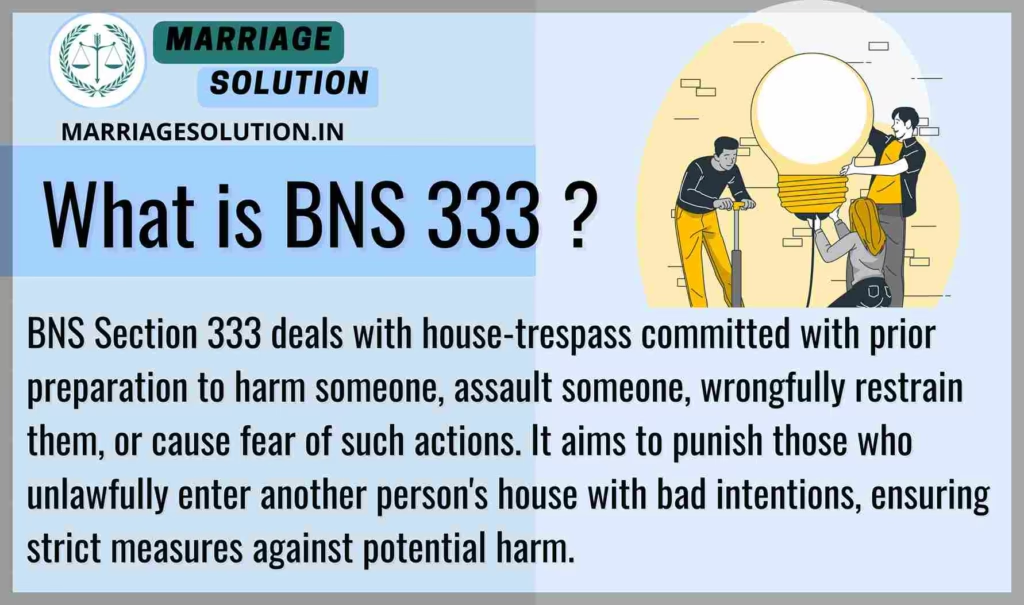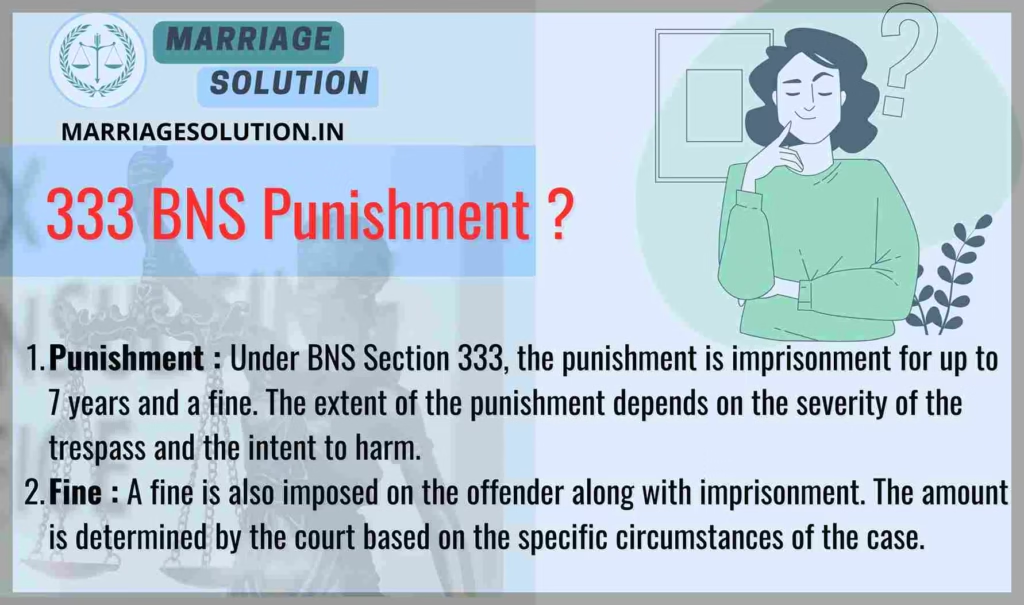Introduction of 333 BNS
333 BNS deals with house-trespass committed after preparation to cause hurt, assault, or wrongful restraint. This provision ensures that offenders who unlawfully enter someone’s home with malicious intent face strict punishment, even if the actual harm has not yet occurred. It highlights the importance of preventing violence before it happens by punishing the intent and preparation.
By replacing IPC Section 452, the new law provides clarity and stronger protection for individuals, families, and properties against intruders who come prepared to cause harm. The law not only punishes physical violence but also the fear and insecurity created by such acts.
The Bharatiya Nyaya Sanhita (BNS) Section 333 replaces the old Indian Penal Code (IPC) Section 452.
What is BNS Section 333 ?
BNS Section 333 deals with house-trespass committed with prior preparation to harm someone, assault someone, wrongfully restrain them, or cause fear of such actions. It aims to punish those who unlawfully enter another person’s house with bad intentions, ensuring strict measures against potential harm.

Under Section 333 of the bns act 2023
“Whoever commits house-trespass after having made preparation for causing hurt, assault, wrongful restraint, or fear of such actions shall be punished with imprisonment of up to seven years and shall also be liable to fine.”
1. Meaning of House-Trespass with Preparation for Harm
- House-trespass becomes an aggravated crime under Section 333 when the offender enters with prior preparation to harm, assault, or restrain someone.
- Preparation may include carrying a weapon, planning to block exits, or arranging tools for violence.
- The law punishes not only the trespass but also the intent and readiness to commit violence.
Example → Entering a house with a knife or iron rod to threaten or injure the residents.
2. Protection of Individuals from Fear and Harm
- This law protects families and individuals inside their homes from violent intrusions.
- Even if no physical harm occurs, the creation of fear through weapons, threats, or restraint is punishable.
- The focus is on safeguarding life, liberty, and the sanctity of homes.
Example → A person breaks into a house at night shouting threats and brandishing a stick, creating fear among the family.
3. Who is Covered?
This section applies to:
- Individuals who unlawfully enter homes with violent intent.
- Groups or mobs who trespass with preparation for collective harm.
- Persons with intent to restrain freedom → like locking residents inside or blocking escape routes.
4. Nature of the Offense
- Cognizable → Police can arrest without a warrant and investigate directly.
- Non-Bailable → The accused cannot claim bail as a right; it requires court approval.
- Non-Compoundable → Cannot be settled privately; the case must be decided in court.
- Trial → Triable by any Magistrate.
5. Punishment under BNS Section 333
- Imprisonment → Up to 7 years.
- Fine → Amount decided by the court, depending on circumstances.
- Both → Courts may impose both imprisonment and fine for deterrence.
6. Examples of BNS Section 333
- Example 1 – Prepared to Attack:
Ravi enters a neighbor’s house carrying a knife during a land dispute. His intent and preparation to cause hurt make him guilty under Section 333, even if no attack occurs. - Example 2 – Prepared to Restrain:
Meena and her friends force entry into a colleague’s house, planning to lock her inside until she agrees to withdraw a complaint. This is house-trespass with preparation for wrongful restraint. - Example 3 – Creating Fear:
Sunil sneaks into a house late at night with a hammer, threatening the family. Even without injury, the act is punishable due to preparation for harm.
7. Importance of BNS Section 333
- Protects citizens from trespassers with violent or harmful intentions.
- Focuses on prevention by punishing preparation, not just actual harm.
- Upholds the sanctity of homes and ensures families feel safe from unlawful intrusions.
- Acts as a deterrent against violence-linked trespass.
Section 333 BNS Overview
BNS Section 333 addresses situations where a person unlawfully enters another’s house (house-trespass) with preparation to cause harm, assault, wrongful restraint, or to instill fear of such actions. This section ensures that such malicious trespassers are punished even before actual harm is caused, focusing on their intentions and preparations.
10 Key Points of BNS Section 333
- What Constitutes House-Trespass
House-trespass occurs when someone enters another person’s home or property without permission. It becomes a crime under this section when the trespasser enters with bad intentions, such as harming or restraining the occupants or creating fear. This ensures the law protects individuals’ safety and privacy. - Preparation for Causing Harm
This section applies if the trespasser has prepared to physically harm someone. For example, carrying weapons like knives, rods, or acid indicates clear intent. The preparation shows their mindset to harm, making them liable under this law even if harm isn’t caused. - Preparation for Assault
Assault involves threatening physical violence or attempting to injure someone. If a person trespasses into a house while being ready to assault someone, the act falls under this section. The focus is on the readiness to act violently, which is punishable. - Preparation for Wrongful Restraint
Wrongful restraint involves stopping someone from moving freely. If a trespasser plans to lock a person inside the house or block exits, this preparation is covered under this law. The act of stopping freedom of movement, even temporarily, is treated as a serious offense. - Instilling Fear of Harm or Assault
Even if no actual harm occurs, creating fear of harm or violence qualifies as a crime under this section. For instance, entering a house while shouting threats or displaying weapons can terrify the occupants and is punishable even if no physical attack follows. - Punishment Details
The offender can be punished with up to 7 years of imprisonment and a fine. The court decides the extent of punishment based on the circumstances, such as the level of preparation, intent, and harm caused. - Cognizable Offense
BNS Section 333 is a cognizable offense, meaning the police can register a case and arrest the offender without prior permission from a magistrate. This ensures quick action to protect victims. - Non-Bailable Nature
Being a non-bailable offense, the accused does not have the right to bail automatically. They must appeal to the court, which evaluates whether to grant bail based on the case’s seriousness and risk. - Non-Compoundable Offense
This offense is non-compoundable, meaning it cannot be settled out of court. The victim and the accused cannot compromise or withdraw the case; only the court can decide the matter to ensure justice. - Trial by Any Magistrate
Cases under this section are triable by any magistrate. This provides flexibility in handling such cases, ensuring they are addressed promptly and effectively, regardless of the magistrate’s level.
Two Simple Examples
- Example 1: Intent to Hurt
- Ravi enters his neighbor’s house with a knife, intending to attack the neighbor during an argument over property boundaries. His entry with a weapon shows preparation for hurt, making him guilty under BNS Section 333.
- Example 2: Creating Fear
- Meena trespasses into her colleague’s house at night after being denied a promotion. She carries a stick and shouts threats, causing the colleague and family to feel scared. Even without physical harm, her actions of fear and preparation fall under this section.
BNS 333 Punishment
Punishment
Under BNS Section 333, the punishment is imprisonment for up to 7 years and a fine. The extent of the punishment depends on the severity of the trespass and the intent to harm.
Fine
A fine is also imposed on the offender along with imprisonment. The amount is determined by the court based on the specific circumstances of the case.

BNS 333 bailable or not ?
BNS Section 333 is non-bailable, meaning the accused cannot automatically get bail and must appeal to the court. The court evaluates the seriousness of the case before deciding on granting bail.
Comparison: BNS Section 333 vs IPC Section 452
| Section | Offense | Punishment | Bailable / Non-Bailable | Cognizable / Non-Cognizable | Trial By |
|---|---|---|---|---|---|
| BNS Section 333 | House-trespass committed after making preparation to cause hurt, assault, wrongful restraint, or creating fear of such actions. | Imprisonment up to 7 years and fine. | Non-Bailable | Cognizable | Any Magistrate |
| IPC Section 452 (Old) | House-trespass committed after preparation for hurt, assault, or wrongful restraint. | Imprisonment up to 7 years and fine. | Non-Bailable | Cognizable | Any Magistrate |
BNS Section 333 FAQs
What does BNS Section 333 punish?
It punishes house-trespass committed with preparation to hurt, assault, restrain, or cause fear.
What is the maximum punishment under this BNS Section 333?
The punishment can go up to 7 years of imprisonment and a fine.
Is this BNS 333 a bailable offense?
No, it is a non-bailable offense.
BNS 333 Can the case be settled out of court?
No, it is non-compoundable, meaning it must be decided in court.
Who can handle cases under this BNS 333?
Cases are triable by any magistrate.
Conclusion
BNS Section 333 plays a crucial role in strengthening home security and personal safety laws. By punishing house-trespass committed after preparation for hurt, assault, or wrongful restraint, it ensures that offenders are held accountable for their intent and planning, not just the outcome. With imprisonment of up to 7 years and a fine, the law acts as a strong deterrent against violent trespass.
This section is a non-bailable, cognizable offense and is triable by a Magistrate, reflecting its seriousness. It reinforces the principle that homes must remain safe spaces, free from intrusion, intimidation, or violence.
Need Legal Support?
If you are dealing with court cases, marriage problems, or any other legal issue, our team at Marriage Solution – Lawyer Help is here for you. Simply fill out our quick online enquiry form, and we’ll connect you with the right legal expert to support your needs.
Finished with BNS 333 ? Continue exploring the next provisions of the Bharatiya Nyaya Sanhita (BNS), 2023. Each section includes explanations, examples, and plain-language breakdowns for easy understanding.
- 334 BNS : Dishonestly breaking open receptacle containing property.
- https://marriagesolution.in/bns_section/334-bns/
CHAPTER XVIII OF OFFENCES RELATING TO DOCUMENTS AND TO PROPERTY MARKS.
- 335 BNS : Dishonestly breaking open receptacle containing property.
- https://marriagesolution.in/bns_section/335-bns/
- 336 BNS : Forgery .
- https://marriagesolution.in/bns_section/336-bns/
- 337 BNS : Forgery of record of Court or of public register, etc .
- https://marriagesolution.in/bns_section/337-bns/
- 338 BNS : Forgery of valuable security, will, etc.
- https://marriagesolution.in/bns_section/338-bns/
Full IPC Section List: https://marriagesolution.in/ipc-section-list
All Indian Law & Blogs: https://marriagesolution.in/indian-law/
Full BNSS Section List: https://marriagesolution.in/bnss_section-list
